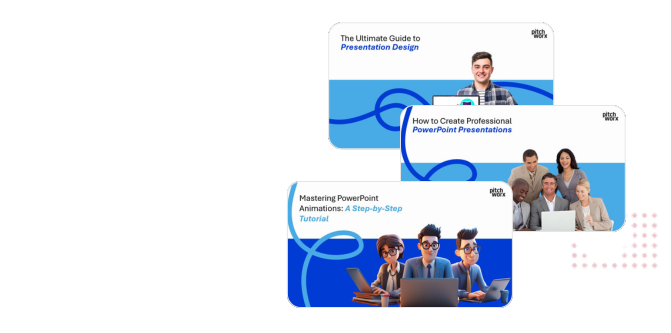Published: October 07, 2025 | Reading Time: 13 minutes | Author: PitchWorx Design Team
Table of Contents
- Quick Answer
- Introduction
- Why Presentation Design Matters
- Principle 1: Visual Hierarchy
- Principle 2: Consistency Throughout
- Principle 3: The Power of Contrast
- Principle 4: Embrace Whitespace
- Principle 5: Typography That Speaks
- Principle 6: Color Psychology and Harmony
- Principle 7: Data Visualization Excellence
- Principle 8: Storytelling Structure
- Principle 9: Image Quality and Relevance
- Principle 10: Accessibility Considerations
- Tools and Resources
- Common Presentation Design Mistakes
- Why Choose Professional Design Services
- Frequently Asked Questions (FAQs)
- Conclusion
Quick Answer
Presentation design basics revolve around five key principles: visual hierarchy, consistency, contrast, whitespace, and storytelling. Professional presentations should balance aesthetics with functionality, using the right typography, color schemes, and data visualization to communicate messages effectively. Following these fundamentals, combined with expert guidance from platforms like Pitchworx, can transform ordinary slides into compelling visual stories that engage audiences and drive results.
Introduction
In today’s business world, presentations are more than just slides with text. They are powerful communication tools that can win clients, secure funding, and inspire teams. Yet, many professionals struggle to create impactful presentations because they lack understanding of design fundamentals. Whether you’re a startup founder, corporate executive, or marketing professional, mastering presentation design basics is essential for success. This comprehensive guide explores the core principles that separate amateur slides from professional presentations.
Why Presentation Design Matters
Research by 3M Corporation shows that presentations with visual aids are 43% more persuasive than those without. Furthermore, studies reveal that people retain 65% of information when paired with relevant images, compared to just 10% when presented through text alone. These statistics prove that design isn’t just about making slides look pretty—it directly impacts how your message is received and remembered.
Case Study: Airbnb Pitch Deck
Airbnb’s early investor pitch deck is a perfect example. Their simple, visually clean presentation helped them secure initial funding despite having no revenue at the time. The deck focused on clear visuals, minimal text, and compelling storytelling—all fundamental design principles we’ll explore in this article.
Principle 1: Visual Hierarchy
Visual hierarchy guides your audience’s eyes through your content in order of importance. This principle ensures that viewers see the most critical information first.
How to Apply Visual Hierarchy:
- Use larger fonts for headlines and key messages
- Position important elements at the top or center of slides
- Create contrast through size, color, and spacing
- Lead the viewer’s eye with directional cues and layouts
Example: When presenting quarterly sales data, your headline should be the main takeaway (e.g., “Sales Increased 45%”), followed by supporting charts, then detailed explanations in smaller text.
Many professionals turn to a Presentation Design Agency like Pitchworx to master these subtle but crucial hierarchy decisions that make presentations effective.
Principle 2: Consistency Throughout
Consistency creates professionalism and helps your audience focus on content rather than being distracted by changing styles.
Elements to Keep Consistent:
- Font families (stick to 2-3 maximum)
- Color palette (primary and secondary colors)
- Icon and image styles
- Spacing and alignment
- Transition effects
Fact: According to Stanford’s Web Credibility Research, 75% of users judge a company’s credibility based on visual design consistency.
When you work with PowerPoint Design Services like those offered by Pitchworx, they ensure brand consistency across every slide, creating a cohesive visual experience.
Principle 3: The Power of Contrast
Contrast makes important elements stand out and improves readability. Without proper contrast, even well-designed slides can fail to communicate effectively.
Types of Contrast to Consider:
- Color Contrast: Use dark text on light backgrounds or vice versa. Ensure sufficient contrast ratios for accessibility (minimum 4.5:1 ratio for body text).
- Size Contrast: Differentiate headlines from body text through significant size differences.
- Weight Contrast: Mix bold and regular fonts to emphasize key points.
- Spatial Contrast: Balance busy areas with whitespace.
A pie chart showing market share should use contrasting colors for each segment. If your company holds 35% market share, that segment should use your brand color and be slightly separated from others to draw attention.
Principle 4: Embrace Whitespace
Whitespace (or negative space) is the empty area around design elements. Many beginners fear empty space and fill every corner with content, creating cluttered, overwhelming slides.
Benefits of Whitespace:
- Improves comprehension and focus
- Creates breathing room for your content
- Conveys sophistication and professionalism
- Guides attention to key elements
Testimonial from Sarah Chen, Marketing Director:
“Before working with Pitchworx, our presentations were cramped with information. Their team taught us that less is more. By embracing whitespace, our conversion rate on sales presentations improved by 28%.”
Professional PowerPoint Design Services understand that strategic emptiness is just as important as the content itself.
Principle 5: Typography That Speaks
Typography affects both readability and emotional response. The right font choices can make your presentation authoritative, friendly, modern, or traditional.
Typography Best Practices:
- Use sans-serif fonts (Arial, Helvetica, Calibri) for body text—they’re easier to read on screens
- Limit yourself to two font families maximum
- Maintain consistent font sizes: headlines (36-44pt), subheadings (24-32pt), body text (18-24pt)
- Avoid decorative fonts except for specific brand purposes
- Never use all caps for body text
Fact: Research from MIT shows that good typography can increase reading comprehension by up to 20%.
Principle 6: Color Psychology and Harmony
Colors evoke emotions and create associations. Understanding color theory is essential for effective presentation design.
Color Psychology Basics:
- Blue: Trust, professionalism, stability (used by 33% of Fortune 500 companies)
- Red: Energy, urgency, passion
- Green: Growth, health, sustainability
- Orange: Creativity, enthusiasm, affordability
- Purple: Luxury, wisdom, spirituality
Color Harmony Rules:
Use the 60-30-10 rule: 60% dominant color, 30% secondary color, 10% accent color. This creates visual balance without overwhelming viewers.
A skilled Presentation Design Agency like Pitchworx applies color psychology to align your visual design with your message and brand values.
Principle 7: Data Visualization Excellence
Numbers alone don’t tell stories—visualizations do. Choosing the right chart type is crucial for communicating data effectively.
Chart Selection Guide:
- Bar Charts: Comparing quantities across categories
- Line Charts: Showing trends over time
- Pie Charts: Displaying parts of a whole (use only when you have 5 or fewer segments)
- Scatter Plots: Revealing correlations between variables
- Infographics: Simplifying complex processes or statistics
Example: When Dropbox wanted to show user growth in their pitch deck, they used a simple line chart with a sharp upward trajectory. This single visual communicated momentum better than any paragraph could.
Case Study: The Uber Pitch Deck
Uber’s original pitch deck used minimal but effective data visualization. Their slide showing “Cab vs. UberCab Pricing” used a simple comparison chart that immediately communicated value. This clarity helped them raise their seed round successfully.
Companies seeking such impactful data visualization often partner with PowerPoint Design Services that specialize in transforming complex information into clear visual stories.
Principle 8: Storytelling Structure
Every great presentation tells a story. Structure your content to create narrative flow that engages and persuades.
Classic Presentation Story Arc:
- Opening: Hook your audience with a compelling question or statistic
- Problem: Define the challenge or opportunity
- Solution: Present your approach or product
- Evidence: Provide data, testimonials, or case studies
- Call to Action: Tell your audience exactly what to do next
Testimonial from Marcus Johnson, Startup Founder:
“We had great technology but struggled to explain it. Pitchworx helped us restructure our investor presentation into a compelling story. We went from zero interest to three term sheets in six weeks.”
Principle 9: Image Quality and Relevance
Images can elevate your presentation or destroy its credibility. Always use high-resolution, relevant imagery.
Image Best Practices:
- Use images at least 1920×1080 pixels for full-slide backgrounds
- Ensure images relate directly to your content
- Avoid cheesy stock photos (people in suits shaking hands, for example)
- Consider custom photography or illustrations for brand uniqueness
- Apply consistent filters or effects across all images
Fact: Presentations with high-quality, relevant images receive 94% more views than those with low-quality visuals, according to content marketing research.
Principle 10: Accessibility Considerations
Professional presentations should be accessible to all audience members, including those with visual impairments.
Accessibility Checklist:
- Maintain sufficient color contrast ratios
- Don’t rely solely on color to convey information
- Include alt text for images (when sharing digitally)
- Use readable font sizes (minimum 18pt)
- Avoid flashing animations that could trigger seizures
- Provide transcripts or notes for important presentations
Working with a professional Presentation Design Agency ensures your presentations meet accessibility standards while maintaining visual appeal.
Tools and Resources
While design principles are fundamental, having the right tools makes implementation easier:
Software Options:
- Microsoft PowerPoint (industry standard)
- Google Slides (collaborative and cloud-based)
- Keynote (Mac users’ preference)
- Canva (beginner-friendly with templates)
Design Resources:
- Unsplash and Pexels (free high-quality images)
- Flaticon (icon libraries)
- Coolors (color palette generator)
- Google Fonts (free typography)
However, for high-stakes presentations like investor pitches or major client proposals, partnering with PowerPoint Design Services like Pitchworx ensures professional-grade results.
Common Presentation Design Mistakes to Avoid
Even with knowledge of principles, professionals often make these errors:
- Reading Directly from Slides: Your slides should complement your speech, not replace it.
- Text Overload: If your slides contain more than 30 words, you’re probably writing too much.
- Inconsistent Animation: Random transitions distract rather than enhance.
- Poor Image Resolution: Pixelated images immediately reduce credibility.
- Ignoring Aspect Ratios: Design for the screen size you’ll be presenting on (16:9 is standard).
Why Choose Professional Design Services
While these principles can improve your presentations, mastering them takes time and practice. This is where Pitchworx becomes invaluable. Pitchworx is a comprehensive Presentation Design Agency offering both community-driven learning and professional PowerPoint Design Services. Their team understands that great design combines artistic skill with strategic communication.
Benefits of working with Pitchworx:
- Access to experienced designers who understand business communication
- Quick turnaround times for time-sensitive presentations
- Both affordable and premium service options
- Portfolio of successful pitch decks and business presentations
- Ongoing design support and revisions
Whether you need a complete deck redesigned or just consulting on design principles, Pitchworx offers flexible solutions for every budget and timeline.
Frequently Asked Questions (FAQs)
1. How many slides should a professional presentation have?
There’s no magic number, but Guy Kawasaki’s 10/20/30 rule is a good guideline: 10 slides, 20 minutes, 30-point minimum font size. For investor pitches, 10-15 slides is ideal. For sales presentations, 20-30 slides may be appropriate if they’re highly visual. Quality always trumps quantity—each slide should serve a clear purpose.
2. Should I use templates or create custom designs?
Templates are excellent starting points, especially for consistency. However, customization is key to standing out. Use templates as frameworks but modify colors, fonts, and layouts to match your brand. For high-stakes presentations, custom designs from a Presentation Design Agency like Pitchworx ensure uniqueness and alignment with your specific goals.
3. How much time should I spend on presentation design?
Budget approximately 30-40% of your total presentation preparation time on design. If you’re spending 10 hours creating a pitch, 3-4 hours should focus on visual design. However, if design isn’t your strength, it’s more efficient to work with PowerPoint Design Services and invest your time in content and delivery practice instead.
4. What’s the difference between business presentations and creative presentations?
Business presentations prioritize clarity, data, and professionalism. They use conservative color schemes, clear typography, and structured layouts. Creative presentations (for industries like advertising or entertainment) can be more experimental with bold colors, unique layouts, and artistic elements. Both should follow fundamental design principles, but creative presentations have more flexibility. Pitchworx specializes in both styles depending on your industry and audience.
5. How do I know if my presentation design is effective?
Test your presentation with a small audience first. Ask: Can they understand your main points within seconds of seeing each slide? Do they remember key messages after viewing? Is anything confusing or distracting? Additionally, track outcomes—whether that’s meetings booked, investments secured, or sales closed. Professional feedback from experts at a Presentation Design Agency can also identify areas for improvement before your big presentation.
Conclusion
Mastering presentation design basics is no longer optional for professionals—it’s essential for effective communication in every industry. By applying these ten principles—visual hierarchy, consistency, contrast, whitespace, typography, color theory, data visualization, storytelling, image quality, and accessibility—you can transform ordinary slides into powerful business tools.
Remember that great presentation design balances aesthetics with functionality. Every visual choice should serve your message and help your audience understand, remember, and act on your content.
While learning these principles is valuable, implementing them at a professional level requires practice, skill, and often time that busy professionals don’t have. This is where Pitchworx makes a difference. As both a learning community and a full-service Presentation Design Agency, Pitchworx offers the perfect solution whether you’re looking to improve your own skills or need expert PowerPoint Design Services for your next important presentation. Your presentations represent you and your organization. Make them count. Apply these principles, avoid common mistakes, and don’t hesitate to seek professional help when stakes are high.










